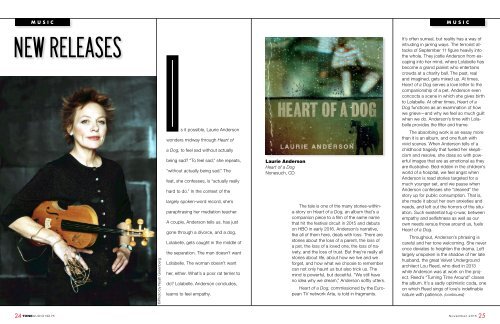Create successful ePaper yourself
Turn your PDF publications into a flip-book with our unique Google optimized e-Paper software.
MUSIC<br />
MUSIC<br />
New Releases<br />
©Photo by Noah Greenberg<br />
Is it possible, Laurie Anderson<br />
wonders midway through Heart of<br />
a Dog, to feel sad without actually<br />
being sad? “To feel sad,” she repeats,<br />
“without actually being sad.” The<br />
feat, she confesses, is “actually really<br />
hard to do.” In <strong>the</strong> context of <strong>the</strong><br />
largely spoken-word record, she’s<br />
paraphrasing her mediation teacher.<br />
A couple, Anderson tells us, has just<br />
gone through a divorce, and a dog,<br />
Lolabelle, gets caught in <strong>the</strong> middle of<br />
<strong>the</strong> separation. The man doesn’t want<br />
Lolabelle. The woman doesn’t want<br />
her, ei<strong>the</strong>r. What’s a poor rat terrier to<br />
do? Lolabelle, Anderson concludes,<br />
learns to feel empathy.<br />
Laurie Anderson<br />
Heart of a Dog<br />
Nonesuch, CD<br />
The tale is one of <strong>the</strong> many stories-withina-story<br />
on Heart of a Dog, an album that’s a<br />
companion piece to a film of <strong>the</strong> same name<br />
that hit <strong>the</strong> festival circuit in 2015 and debuts<br />
on HBO in early 2016. Anderson’s narrative,<br />
like all of <strong>the</strong>m here, deals with loss. There are<br />
stories about <strong>the</strong> loss of a parent, <strong>the</strong> loss of<br />
a pet, <strong>the</strong> loss of a loved one, <strong>the</strong> loss of naivety,<br />
and <strong>the</strong> loss of trust. But <strong>the</strong>y’re really all<br />
stories about life, about how we live and we<br />
forget, and how what we choose to remember<br />
can not only haunt us but also trick us. The<br />
mind is powerful, but deceitful. “We still have<br />
no idea why we dream,” Anderson softly utters.<br />
Heart of a Dog, commissioned by <strong>the</strong> European<br />
TV network Arte, is told in fragments.<br />
It’s often surreal, but reality has a way of<br />
intruding in jarring ways. The terrorist attacks<br />
of September 11 figure heavily into<br />
<strong>the</strong> whole. They jostle Anderson from escaping<br />
into her mind, where Lolabelle has<br />
become a grand pianist who entertains<br />
crowds at a charity ball. The past, real<br />
and imagined, gets mixed up. At times,<br />
Heart of a Dog serves a love letter to <strong>the</strong><br />
companionship of a pet. Anderson even<br />
concocts a scene in which she gives birth<br />
to Lolabelle. At o<strong>the</strong>r times, Heart of a<br />
Dog functions as an examination of how<br />
we grieve—and why we feel so much guilt<br />
when we do. Anderson’s time with Lolabelle<br />
provides <strong>the</strong> filter and frame.<br />
The absorbing work is an essay more<br />
than it is an album, and one flush with<br />
vivid scenes. When Anderson tells of a<br />
childhood tragedy that fueled her skepticism<br />
and resolve, she does so with powerful<br />
images that are as emotional as <strong>the</strong>y<br />
are illustrative. Bed-ridden in <strong>the</strong> children’s<br />
world of a hospital, we feel angst when<br />
Anderson is read stories targeted for a<br />
much younger set, and we pause when<br />
Anderson confesses she “cleaned” <strong>the</strong><br />
story up for public consumption. That is,<br />
she made it about her own anxieties and<br />
needs, and left out <strong>the</strong> horrors of <strong>the</strong> situation.<br />
Such existential tug-o-war, between<br />
empathy and selfishness as well as our<br />
own needs versus those around us, fuels<br />
Heart of a Dog.<br />
Throughout, Anderson’s phrasing is<br />
careful and her tone welcoming. She never<br />
once deviates to heighten <strong>the</strong> drama. Left<br />
largely unspoken is <strong>the</strong> shadow of her late<br />
husband, <strong>the</strong> great Velvet Underground<br />
architect Lou Reed, who died in 2013<br />
while Anderson was at work on <strong>the</strong> project.<br />
Reed’s “Turning Time Around” closes<br />
<strong>the</strong> album. It’s a sadly optimistic coda, one<br />
on which Reed sings of love’s indefinable<br />
nature with patience. (continued)<br />
24 TONE AUDIO NO.75<br />
November 2015 25


